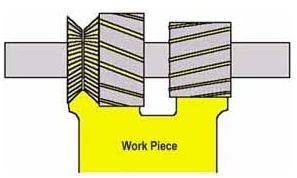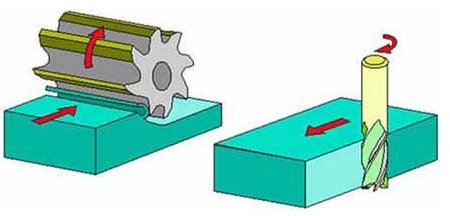Milling Machine: Methods of Milling. Milling Processes
Introduction to Milling
Milling is an important process of manufacturing technology and basically it refers to the removal of metal from the work piece using a tool which has several cutting points and is rotating about its axis. Thus each cutting point removes a little bit of the metal but since there are multiple such points and the tool is rotating at a fast speed, the overall removal is quite brisk.
The main advantage of the milling machine is that it can be used to perform literally any operation with a great degree of accuracy and hence it is an indispensable machine for any workshop worth its salt.
Milling machines come in a wide variety of flavours such as universal, horizontal, vertical, drum type to name a few. Each of these have their own unique features and used for various operations. We won’t go in these details in this article but will try to see what sort of milling methods can be deployed using these machines as follows.
Methods of Milling
Given below are few of the most commonly used milling methods in the manufacturing industry. This list is certainly not exhaustive but only indicative of the wide variety of uses that a milling machine can be put to in the industry.
Single piece milling – this method is used for milling a single job work which is held on the milling machine. It is important to note that the piece has to be worked in a single machine cycle for it to be classified under this category of milling methods.
String milling is quite similar to single piece milling but the only difference being that instead of a single piece there are several parts which is simultaneously fixed and are worked upon.
Index milling refers to a special kind of milling operation wherein the machine is set to perform identical operations on a work piece. Each of these identical operations is performed one after the other by indexing the work piece into a new position. A very good example of such a process is the gear cutting operation wherein the gear grooves are cut in succession one after the other.
Copy milling technique refers to where a design or cut is difficult to make by itself, hence it is first made in the form of a master template which is turn is used to guide the tool path. Hence basically the template acts as an original from which the other parts are copied just like you would photocopy a document from an original paper in the Xerox machine.
Gang milling refers to the situation when a gang or group of cutters is used to simultaneously work on the work piece in order to produce the desired shape

Reciprocal milling refers to the process wherein the time taken to load and upload the job work from the fixture on the milling table is minimized by utilizing two fixtures which are ready at the same time for milling one after the other.
There are several other types of milling methods apart from these and each of these methods have their own unique features. The reader is advised to refer to any good textbook of Production Technology in case he/she is interested to gain advanced knowledge about this area of manufacturing technology
Image Credits
The Hong Kong Polytechnic University: Machining and Metrology Unit Website
